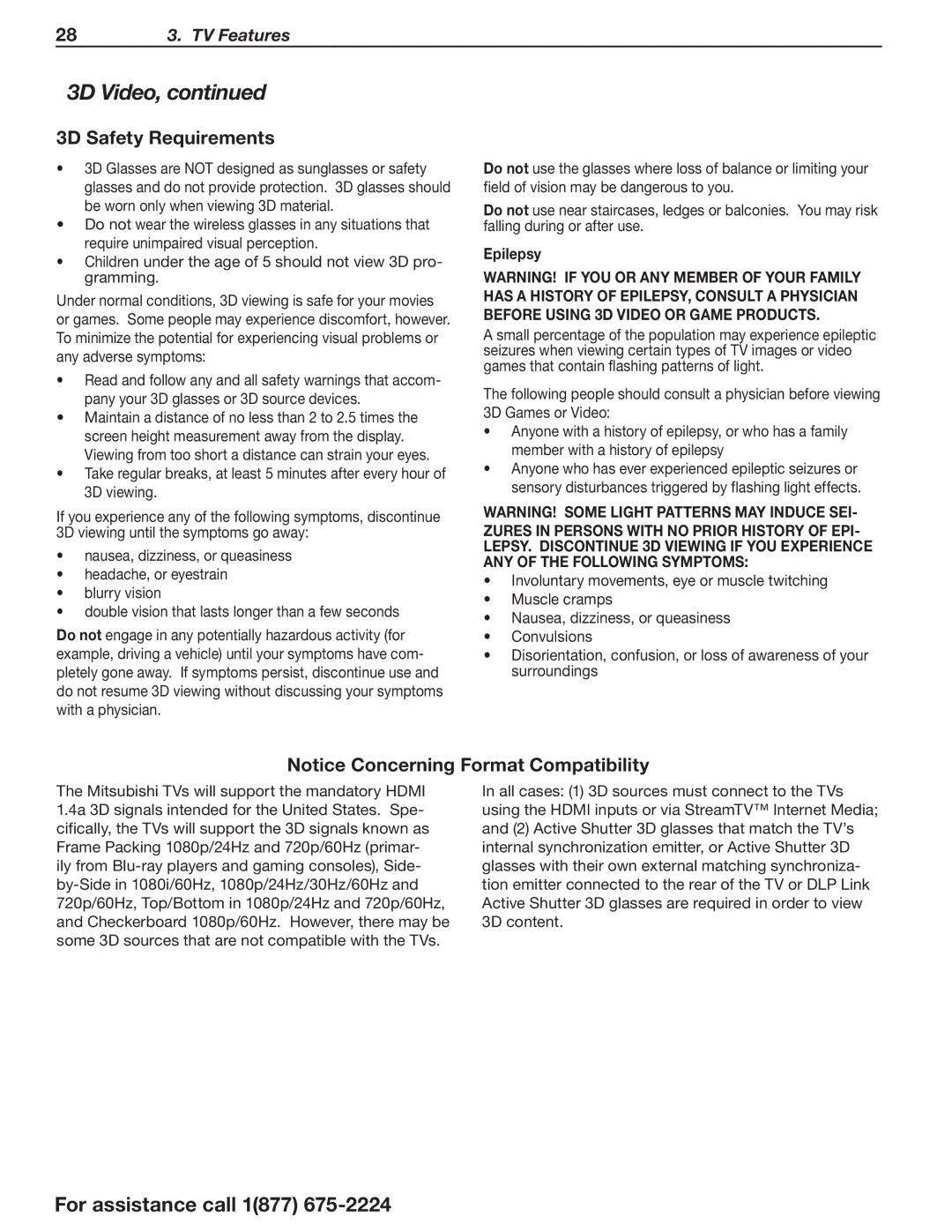283. TV Features
3D Video, continued
3D Safety Requirements
•3D Glasses are NOT designed as sunglasses or safety glasses and do not provide protection. 3D glasses should be worn only when viewing 3D material.
•Do not wear the wireless glasses in any situations that require unimpaired visual perception.
•Children under the age of 5 should not view 3D pro- gramming.
Under normal conditions, 3D viewing is safe for your movies or games. Some people may experience discomfort, however. To minimize the potential for experiencing visual problems or any adverse symptoms:
•Read and follow any and all safety warnings that accom- pany your 3D glasses or 3D source devices.
•Maintain a distance of no less than 2 to 2.5 times the screen height measurement away from the display. Viewing from too short a distance can strain your eyes.
•Take regular breaks, at least 5 minutes after every hour of 3D viewing.
If you experience any of the following symptoms, discontinue
3D viewing until the symptoms go away:
•nausea, dizziness, or queasiness
•headache, or eyestrain
•blurry vision
•double vision that lasts longer than a few seconds
Do not engage in any potentially hazardous activity (for example, driving a vehicle) until your symptoms have com- pletely gone away. If symptoms persist, discontinue use and do not resume 3D viewing without discussing your symptoms with a physician.
Do not use the glasses where loss of balance or limiting your field of vision may be dangerous to you.
Do not use near staircases, ledges or balconies. You may risk falling during or after use.
Epilepsy
WARNING! IF YOU OR ANY MEMBER OF YOUR FAMILY HAS A HISTORY OF EPILEPSY, CONSULT A PHYSICIAN BEFORE USING 3D VIDEO OR GAME PRODUCTS.
A small percentage of the population may experience epileptic seizures when viewing certain types of TV images or video games that contain flashing patterns of light.
The following people should consult a physician before viewing
3D Games or Video:
•Anyone with a history of epilepsy, or who has a family member with a history of epilepsy
•Anyone who has ever experienced epileptic seizures or sensory disturbances triggered by flashing light effects.
WARNING! SOME LIGHT PATTERNS MAY INDUCE SEI-
ZURES IN PERSONS WITH NO PRIOR HISTORY OF EPI- LEPSY. DISCONTINUE 3D VIEWING IF YOU EXPERIENCE ANY OF THE FOLLOWING SYMPTOMS:
•Involuntary movements, eye or muscle twitching
•Muscle cramps
•Nausea, dizziness, or queasiness
•Convulsions
•Disorientation, confusion, or loss of awareness of your surroundings
Notice Concerning Format Compatibility
The Mitsubishi TVs will support the mandatory HDMI 1.4a 3D signals intended for the United States. Spe- cifically, the TVs will support the 3D signals known as Frame Packing 1080p/24Hz and 720p/60Hz (primar- ily from
In all cases: (1) 3D sources must connect to the TVs using the HDMI inputs or via StreamTV™ Internet Media; and (2) Active Shutter 3D glasses that match the TV’s internal synchronization emitter, or Active Shutter 3D glasses with their own external matching synchroniza- tion emitter connected to the rear of the TV or DLP Link Active Shutter 3D glasses are required in order to view 3D content.
For assistance call 1(877)
